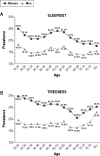Age and sleep disturbances among American men and women: data from the U.S. Behavioral Risk Factor Surveillance System
- PMID: 22379246
- PMCID: PMC3274341
- DOI: 10.5665/sleep.1704
Age and sleep disturbances among American men and women: data from the U.S. Behavioral Risk Factor Surveillance System
Abstract
Study objective: Explore the prevalence of sleep-related complaints across age groups, examining effects of sex, general health, and depressed mood.
Design: Cross-sectional analysis of data from the 2006 Behavioral Risk Factor Surveillance System (BRFSS).
Setting: Epidemiologic.
Participants: Complete-case analysis included 155,877 participants who responded to questions related to Self-Reported Sleep Disturbance (SLEEPDIST) and Self-Reported Tiredness/Lack of Energy (TIREDNESS).
Interventions: None.
Measurements and results: Outcomes were self-reported complaints in response to survey questions assessing SLEEPDIST and TIREDNESS, dichotomized as reporting a complaint < 6 versus ≥ 6 nights or days, respectively, in a 2-wk period. Predictors were age, general health, and depressed mood. All analyses were adjusted for race/ethnicity, income, education, and time since last medical checkup. Across all age groups, women reported more SLEEPDIST and TIREDNESS. Poor general health, mild depressed mood, and moderate/severe depressed mood were associated with SLEEPDIST and TIREDNESS. Both SLEEPDIST and TIREDNESS generally declined across the life span, with fewest endorsements in respondents older than 80 yr. For SLEEPDIST, odds ratios (ORs, reference = 80+) declined from age 18-54 yr, rose slightly, and then declined again after age 59 yr in men. The pattern was similar for women, except a more marked rise was noted from age 40-59 yr. The pattern was similar for TIREDNESS.
Conclusions: Advancing age was not associated with increased Self-Reported Sleep Disturbance or Self-Reported Tiredness/Lack of Energy. These results suggest that the often-reported increase in sleep problems with age is a nonlinear phenomenon, mediated by factors other than physiologic aging.
Keywords: Aging; depression; epidemiology; fatigue; sleep quality.
Figures





References
-
- Soldatos CR, Allaert FA, Ohta T, Dikeos DG. How do individuals sleep around the world? Results from a single-day survey in ten countries. Sleep Med. 2005;6:5–13. - PubMed
-
- Ohayon MM. Prevalence of DSM-IV diagnostic criteria of insomnia: distinguishing insomnia related to mental disorders from sleep disorders. J Psychiatr Res. 1997;31:333–46. - PubMed
-
- Liu X, Uchiyama M, Kim K, Okawa M, Shibui K, Kudo Y, et al. Sleep loss and daytime sleepiness in the general adult population of Japan. Psychiatry Res. 2000;93:1–11. - PubMed
-
- Asplund R. Daytime sleepiness and napping amongst the elderly in relation to somatic health and medical treatment. J Intern Med. 1996;239:261–7. - PubMed
-
- Vitiello MV, Moe KE, Prinz PN. Sleep complaints cosegregate with illness in older adults: clinical research informed by and informing epidemiological studies of sleep. J Psychosom Res. 2002;53:555–9. - PubMed
Publication types
MeSH terms
Grants and funding
LinkOut - more resources
Full Text Sources
Medical

